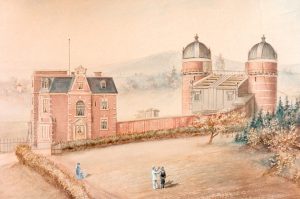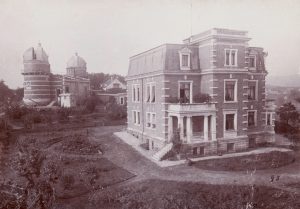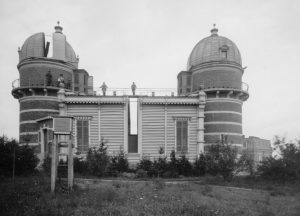Observatory Buildings



Die deutsche Textfassung finden Sie hier.
The observatory consists of a main building and an observation building with a meridian hall and two domes in an eastern-to-western direction. Both buildings are connected with a corridor, which is used as an exhibition site for historical documents and instruments today. Additionally, there is an annex built in 1860, which hosted the mechanical workshop until 2007.
The western dome was equipped with a 10″ refractor telescope, the eastern dome with a heliometer. This instrument can be seen in the Deutsches Museum in Munich. For more than 70 years, the main research topics were the observation of variable stars as well as the systematic monitoring of the northern hemisphere together with the observatories in Babelsberg and Sonneberg. After the end of the Bamberg survey in 1962, the monitoring was extended to the southern hemisphere. With the help of the Deutsche Forschungsgemeinschaft, the scientists of the Dr. Karl Remeis-Observatory maintained an outstation at the Boyden Observatory in South Africa. The yield of about 40,000 photographic plates is complete extant. The photographic plate archive is located in the old workshop.
In 2012, the DFG started financing a project to digitize all the photographic plates — some of them more than a hundred years old — with high resolution scanners. Thus, the valuable historic observations are preserved and made available to scientists worldwide via the APPLAUSE database.
In 1946, the eastern dome was equipped with a 60 cm reflector telescope, and since 1985 the western dome features a 40 cm reflector telescope. Recently, both instruments were replaced by modern, computer-controlled reflector telescopes, now used for education. The meridian hall was modified to accomodate the institute library consisting of numerous international journals, historically relevant publications of 263 observatories from all over the world, as well as more than 2000 textbooks.
The international decision to build a joint European Southern Observatory (ESO) in Chile in the early 1960s drew a close to all smaller sized observatories. Nowadays, even the smallest institutes can make use of the largest and most modern instruments of European astronomy.



